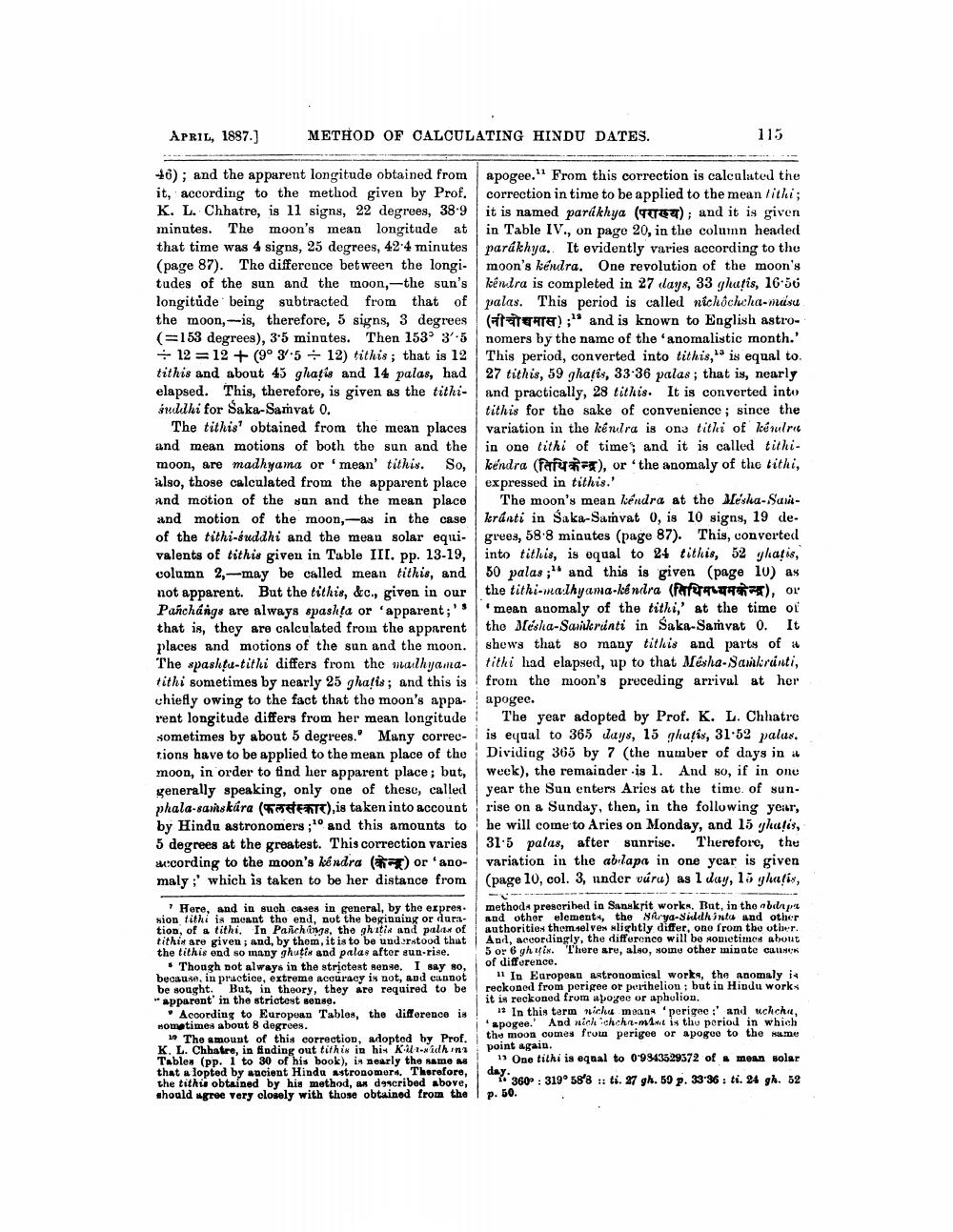________________
APRIL, 1887.)
METHOD OF CALCULATING HINDU DATES.
115
46); and the apparent longitude obtained from apogee." From this correction is calculated the it, according to the method given by Prof. correction in time to be applied to the mean lithi; K. L. Chhatre, is 11 signs, 22 degrees, 38.9 it is named parikhya (TTE); and it is given minutes. The moon's mean longitude at in Table IV., on page 20, in the column headed that time was 4 signs, 25 degrees, 42 4 minutes parákhya. It evidently varies according to the (page 87). The difference between the longi. moon's kendra. One revolution of the moon's tudes of the sun and the moon,--the sun's kenira is completed in 27 days, 33 ghutis, 16-50 longitude being subtracted from that of palas. This period is called nichóchcha-musu the moon,-is, therefore, 5 signs, 3 degrees (ITATE);" and is known to English astro(=153 degrees), 35 minutes. Then 153' 3.5
nomers by the name of the 'anomalistic month.' 12 = 12 + (9° 3.5 – 12) tithis; that is 12 This period, converted into tithis, is equal to tithis and about 45 ghatis and 14 palas, had 27 tithis, 59 ghalis, 33-36 palas; that is, nearly elapsed. This, therefore, is given as the tithi- and practically, 28 tithis. It is converted into šuddhi for Saka-Samvat 0.
tithis for the sake of convenience; since the The tithis' obtained from the mean places variation in the kênulra is ona titki of lerulre and mean motions of both the sun and the in one tithi of time, and it is called tithimoon, are madhyama or mean' tithis. So, kendra (faru ), or the anomaly of the tithi, also, those calculated from the apparent place expressed in tithis.' and motion of the son and the mean place | The moon's mean léndra at the Mesha-Saisand motion of the moon,-as in the case kranti in Saka-Samvat 0, is 10 signs, 19 de. of the tithi-suddhi and the mean solar equi- grees, 58.8 minutes (page 87). This, converted valents of tithis given in Table III. pp. 13-19, into tithis, is equal to 24 tithis, 52 ghatis, column 2,- may be called mean tithis, and 50 palas ;" and this is given (page 10) as not apparent. But the tithis, &c., given in our the tithi-
walhyama-kéndra (for ), or Panchangs are always spashţa or 'apparent;': 'mean anomaly of the tithi,' at the time of that is, they are calculated from the apparent the Mesha-Sankrinti in Saka-Samvat 0. It places and motions of the sun and the moon. shews that so many tithis and parts of it The spashtu-tithi differs from the malhyama- tithi had elapsed, up to that Mésha-Sankranti, tithi sometimes by nearly 25 ghalis; and this is from the moon's preceding arrival at her chiefly owing to the fact that the moon's appaapogee. rent longitude differs from her mean longitude: The year adopted by Prof. K. L. Chhatre sometimes by about 5 degrees. Many correc- ! is equal to 365 days, 15 ghutis, 31:52 palas. tions have to be applied to the mean place of the Dividing 365 by 7 (the number of days in a moon, in order to tind her apparent place; but, week), the remainder is 1. And so, if in one generally speaking, only one of thesc, called year the Sun enters Aries at the time of sunphala-sarskára ( EET),is taken into account rise on a Sunday, then, in the following year, by Hindu astronomers ; ho and this amounts to he will come to Aries on Monday, and 15 yhatis, 5 degrees at the greatest. This correction varies 31.5 palas, after sunrise. Therefore, the according to the moon's kéndra ( ) or 'ano- variation in the abilapа in one year is given maly ;' which is taken to be her distance from (page 10, col. 3, under vúru) as 1 day, 15 ghalis,
Here, and in such cases in general, by the expres. sion tithi is meant the end, not the beginning or dura tion, of a tithi. In Panchings, the ghitis and pal1 of tithin are given and, by them, it is to be understood that the tithis end so many ghutis and palas after sun-rise.
• Though not always in the strictest sense. I say so, because, in practice, extreme accuracy is not, and cannot be sought. But, in theory, they are required to be ** apparent' in the strictest sense.
According to European Tables, the difference is sometimes about 8 degrees.
The amount of this correction, adopted by Prof. K. L. Chhatre, in finding out tithis in his Kult-xichina Tablen (pp. 1 to 30 of his book), is nearly the same as that a lopted by ancient Hinda astronomers. Therefore, the tithi obtained by his method, as described above, should agree very closely with those obtained from the
methods prescribed in Sanskrit works. But, in the abilpe and other element, the Narya-Shehindu and other authorities themselves slightly differ, one from the utile And, accordingly, the difference will be monetimes about 5 o 6 ghuis. There are, also, noiny other minate cat of difference.
11 In European astronomical works, the anomaly 14 reckoned from porigee or perihelion ; but in Hindu work it is reckoned from apogee or aphulion.
19 In this term wicha means 'perigec :' and uchchu, apogee. And nich ichche-mintis thu period in which the moon comes fruta perigee or apogeo to the same point again. 19 One tithi is equal to 0-9843629572 of moun solar
360°: 319° 583 :: ti. 27 gh. 50 p. 33-36 : ti. 24 gł. 52 p. 50.




